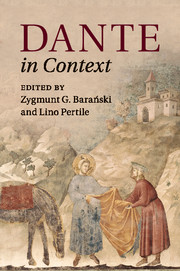Book contents
- Frontmatter
- Dedication
- Contents
- List of illustrations
- List of maps
- Notes on contributors
- Chronology
- Abbreviations and note on translations
- Introduction
- Part I Politics and society
- Part II Intellectual traditions
- Part III Linguistic and literary cultures
- 15 Linguistic Italy
- 16 Education
- 17 Rhetoric, literary theory, and practical criticism
- 18 Classical antiquity
- 19 Religious culture
- 20 Visions and journeys
- 21 Historical and political writing
- 22 Vernacular literatures
- 23 Popular culture
- Part IV Visual and performative culture
- Part V Dante: life, works, and reception
- Further reading
- Index
16 - Education
from Part III - Linguistic and literary cultures
Published online by Cambridge University Press: 05 October 2015
- Frontmatter
- Dedication
- Contents
- List of illustrations
- List of maps
- Notes on contributors
- Chronology
- Abbreviations and note on translations
- Introduction
- Part I Politics and society
- Part II Intellectual traditions
- Part III Linguistic and literary cultures
- 15 Linguistic Italy
- 16 Education
- 17 Rhetoric, literary theory, and practical criticism
- 18 Classical antiquity
- 19 Religious culture
- 20 Visions and journeys
- 21 Historical and political writing
- 22 Vernacular literatures
- 23 Popular culture
- Part IV Visual and performative culture
- Part V Dante: life, works, and reception
- Further reading
- Index
Summary
Florentine society was highly literate in the later Middle Ages. Writing at the end of the 1330s, Giovanni Villani (c.1275–1348) provided the following statistics of children attending school in the city of Florence: ‘We find that there are eight to ten thousand boys and girls at reading school; between a thousand and twelve hundred boys at six abacus schools; and five hundred and fifty to six hundred learning grammar and logic in four large schools.’ According to one interpretation, this estimate suggests that the male schooling rate in Florence was between 67 to 83 per cent. The accuracy of Villani's figures has been doubted, but in fact they tally with the picture of literacy disclosed by the Florentine tax records (catasto) of 1427.
Mass literacy, as suggested by Villani and confirmed by the Florentine catasto, was the product of a highly developed education system and syllabus. In later medieval Florence there were three types of schools for pre-university education. The first step was basic reading, taught in elementary schools by teachers normally called doctores puerorum (teachers of boys); this skill was always acquired through the medium of the Latin language. For pupils who continued in formal education, the next stage was the continued study of Latin at a grammar school (grammar was a synonym for Latin, and was normally used in that sense by Dante). An alternative syllabus focused on elementary arithmetic, known as abaco or abbaco, involving not the instrument for calculation now known as the abacus (by the beginning of the thirteenth century, abacus was a synonym for arithmetic), but rather consisting of a course, beginning with elementary arithmetic and culminating in basic commercial knowledge; the abacus was taught entirely in the vernacular. The first abacus teachers began to appear in Florence and Tuscany in the late 1270s; there is no evidence, however, that Dante attended an abacus school, and so this form of education will not be further considered here. Writing was taught after elementary reading by doctores puerorum, grammar masters, and abacus teachers.
Elementary reading and writing
The first textbooks were usually called tabula or carta, salterium, and donatus. Tabula or carta was a sheet of parchment or paper that began with the alphabet and concluded with syllables to sound out; it was fixed on a wooden board and took its name either from the parchment or paper (carta) or from the board (tabula).
- Type
- Chapter
- Information
- Dante in Context , pp. 260 - 276Publisher: Cambridge University PressPrint publication year: 2015
- 2
- Cited by



